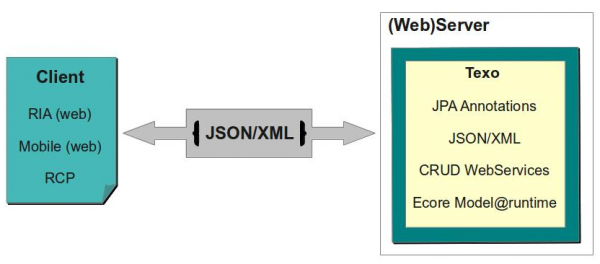Hi!
As always, Eclipsecon was an inspiration to finally implement those features which I always wanted to do. This time it was implementing JSON REST web service support in Texo. This new feature is based on my experience implementing RIA user interfaces for business web apps.
Texo automatically provides the JSON REST web service support using the ecore/xsd domain model. So with just a few lines of code your domain model is accessible from browser/mobile web UIs.

Why would it be a good idea to try out and use the Texo JSON functionality? Well first it is quite feature complete, supporting full CRUD, querying in multiple ways, individual update/inserts, mass delete/update/insert, proxying, etc. The second good reason is that it is based on real application experience, this explains why attention has been paid to details as querying for multiple values to fill a grid, record counting and object titles. The third good reason: the combination of JSON REST with the other Texo features (JPA entity generation, runtime layer, etc.) makes it possible to have a running feature-complete JSON REST function within a few minutes, generated from an ecore/xsd model.
Texo JSON runs typically in a web container like Tomcat. The example project illustrates how to set this up. After installing/running the solution in a web container, you can for example do these type of uris/queries to retrieve information:
- http://localhost:8080/texo/jsonws/Writer/1
- http://localhost:8080/texo/jsonws/Writer
- http://localhost:8080/org.eclipse.emf.texo.web.example/jsonws?query=select e from Writer e
The first example will retrieve a single object in JSON format, the second all Writer objects and the third example shows how a free-format query can be passed. Security and SQL injection prevention are important topics here to.
Insert/update are supported through POST http methods, deletion is done through the DELETE http method.
Other features of the Texo JSON REST support:
- Paging parameters to support efficient scrolling through a large grid of data
- Setting the number of levels in the containment tree which should be returned
- The proxy concept, references are sent back with a proxy uri, to prevent reading the complete database
- Several ways of doing insert/update
- Combining multiple insert/update/delete actions in one request
As a next step I am considering implementing a few example web apps using client side UI technology as provided by sencha or even try to connect a RCP with an EMF UI to the Texo JSON layer.
Thanks for reading and I hope this blog post helps to give Texo a try. Visit the Texo wiki for more information. Let me know if you have any questions or remarks on the EMFT newsgroup or forum.
gr. Martin
